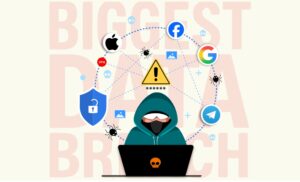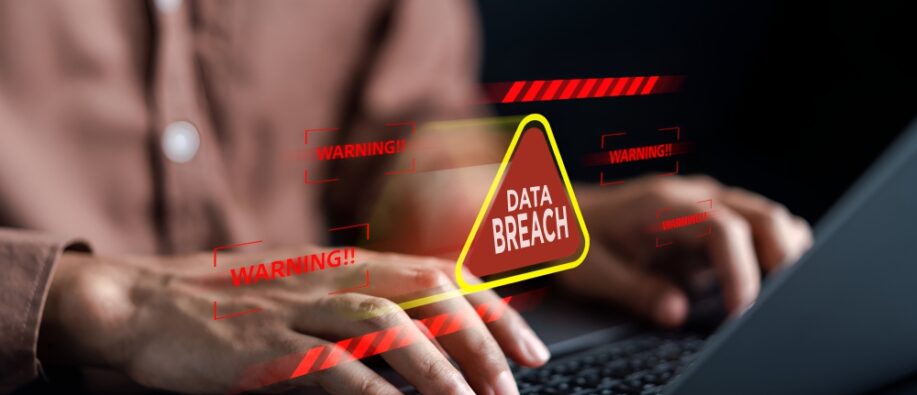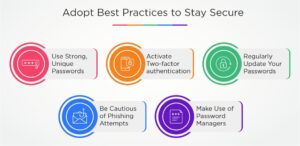Cybersecurity researchers recently uncovered what is being called the “Mother of All Breaches” (MOAB). A staggering 16 billion login credentials were exposed in what may be the largest data breach passwords leak in history. This isn’t just another security alert. It is a wake-up call for every internet user. The humongous leak has compromised tens of millions of accounts, with people and companies rushing to secure their details.
The Unfolding of the Largest Data Leak
The recent data breach passwords have created waves around the world. Security researchers discovered 30 databases worth billions of login credentials, URLs, and passwords. It was not merely reused for old breaches but new, weaponizable intelligence on a massive scale. The breach contains data breach passwords from popular sites such as Apple, Google, Facebook, Telegram, GitHub, numerous VPN providers, and even government websites.

Understanding the Scale of this Breach
This massive data breach passwords compilation contains passwords and usernames from thousands of past breaches, including major platforms like:
- LinkedIn (2012 breach)
- Adobe (2013 breach)
- Dropbox (2016 breach)
- Twitter (2021 breach)
What makes this particularly dangerous is that cybercriminals have now consolidated all these leaks into a single, easily accessible database. Even if you changed your password years ago, hackers could still use old credentials to attempt access to your other accounts through credential-stuffing attacks.
The Impact of the Data Breach
The sheer volume of exposed data breach passwords is staggering. With 26 billion records compromised, cybercriminals now have unprecedented access to personal credentials. This data can be used for account takeovers, identity theft, and highly targeted phishing attacks. The structure and recency of these datasets make them particularly dangerous, as they provide a blueprint for mass exploitation.
Why This Should Concern You?
Many of us reuse passwords across multiple accounts for convenience. If just one of your old passwords was part of this leak, hackers could potentially:
- Access your email accounts
- Break into social media profiles
- Attempt bank account logins
- Sell your credentials on the dark web
Recent examples show how dangerous this can be:
- In 2023, a similar consolidated breach led to a surge in PayPal and banking fraud cases
- Last year, Uber employees were hacked by reusing credentials from an old data breach password.
How Did This Happen?
The leak is believed to be the work of several info stealers, who collect information via malware and phishing attacks before dumping them out into these colossal collections.
The newly leaked dataset are highly exploitable and are fresh, they are way different from the old breaches that are sometimes recycled on dark web forums. This makes it highly important for everyone to move swiftly to secure their accounts.
How to Check If Your Data Was Compromised?
You don’t need to wait to become a victim. Here are two reliable ways to check:
- Have I Been Pwned (haveibeenpwned.com): Enter your email to see if your data breach passwords appears in known breaches.
- Google Password Manager: If you use Chrome, check the built-in password health tool.
Best Practices to Stay Safe
To protect your information, it is necessary to adopt best practices. Follow these steps:
1. Use Strong, Unique Passwords
Avoid using the same password for several accounts. Create strong, unique passwords for each account to reduce the chances of a single breach putting multiple accounts at risk.
2. Activate Two-factor authentication
Two-factor authentication increases the security of your account, as it adds an extra layer of security to it. As it requires a second form of verification, such as a code sent to your phone. This restricts cybercriminals from accessing your account, though they have your password with them.
3. Regularly Update Your Passwords
Change your passwords regularly. This will reduce the risk of the account on being compromised. Set reminders to update your password every few months.
4. Be Cautious of Phishing Attempts
Be aware of messages, emails, or websites that ask you for your personal information. Verify the source before you click on any links or provide details.
5. Make Use of Password Managers
Password managers can help you in creating and keeping strong passwords securely. These tools help you avoid reusing data breach passwordsThey also simplify the management of numerous accounts without the necessity of remembering each password.
6. Keep Your Accounts Under Watch
Keep your accounts checked regularly for any unusual activity. If you see something is not right, act instantly to protect your account.
The Future of Data Security
As technology continues to advance, the need for data security is becoming more important than ever. Companies and individuals must stay careful and proactive in securing their data. Following are some aspects to look into:
Invest in Customization
Pre-made solutions may not be sufficient in the long run. Having customization in your security solutions so that you can meet the required needs will keep you ahead of threats.
Boosting Ethics and Trust
With increasing usage of technology, consumers will care more about the manner in which their information is treated. Transparency and good data practices can become a point of differentiation in themselves.
Final Thoughts: Protecting Your Digital Life
The largest data leak in history serves as a harsh reminder of the weaknesses in our digital world. It tells us we must take data breach passwords seriously. By embracing best practices and staying aware, we can protect our information and reduce the risk of cyber threats. Remember, the key to safety is a constant and proactive effort.
FAQs
Q1: Is it safe to use the same password for multiple accounts?
Answer: No, it is not safe to use the same password for multiple accounts, as it increases the risk of all your accounts being compromised.
Q2: How frequently should I change the password?
Answer: One should change their password every few months to reduce the risk of getting hacked.
Q3: Does two-factor authentication really protect my accounts?
Answer: Yes, two-factor authentication adds an extra layer of security. It makes it harder for cybercriminals to access your accounts even if they have your password.
Recommended reads:
Data Breaches: How do you protect your company’s valuables?
Passwordless Authentication: The Smarter Way to Say Goodbye to Passwords!
Key Security Challenges and Solutions for Ensuring Data Privacy on Internet of Things (IoT)






